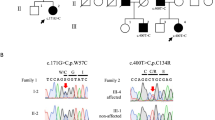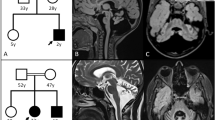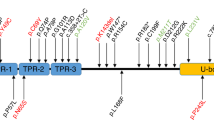Abstract
The microtubule-associated protein tau (encoded by MAPT) and several tau kinases have been implicated in neurodegeneration, but only MAPT has a proven role in disease. We identified mutations in the gene encoding tau tubulin kinase 2 (TTBK2) as the cause of spinocerebellar ataxia type 11. Affected brain tissue showed substantial cerebellar degeneration and tau deposition. These data suggest that TTBK2 is important in the tau cascade and in spinocerebellar degeneration.
This is a preview of subscription content, access via your institution
Access options
Subscribe to this journal
Receive 12 print issues and online access
$209.00 per year
only $17.42 per issue
Buy this article
- Purchase on Springer Link
- Instant access to full article PDF
Prices may be subject to local taxes which are calculated during checkout


Similar content being viewed by others
References
Schols, L. et al. Lancet Neurol. 3, 291–304 (2004).
Harding, A.E. Brain 105, 1–28 (1982).
Ranum, L.P. & Day, J.W. Curr. Opin. Genet. Dev. 12, 266–271 (2002).
Orr, H.T. & Zoghbi, H.Y. Annu. Rev. Neurosci. 30, 575–621 (2007).
Worth, P.F. et al. Am. J. Hum. Genet. 65, 420–426 (1999).
Baker, M. et al. Nature 442, 916–919 (2006).
Riudavets, M.A. et al. J. Neuropathol. Exp. Neurol. 65, 1143–1148 (2006).
Mann, D.M. et al. Neuropathol. Appl. Neurobiol. 16, 17–25 (1990).
Mukaetova-Ladinska, E.B. et al. Am. J. Pathol. 143, 565–578 (1993).
Ballatore, C., Lee, V.M. & Trojanowski, J.Q. Nat. Rev. Neurosci. 8, 663–672 (2007).
Takahashi, M. et al. FEBS Lett. 372, 59–64 (1995).
Sato, S. et al. J. Neurochem. 98, 1573–1584 (2006).
Kitano-Takahashi, M. et al. Acta Crystallograph. Sect. F Struct. Biol. Cryst. Commun. 63, 602–604 (2007).
Noble, W. et al. Proc. Natl. Acad. Sci. USA 102, 6990–6995 (2005).
Kraemer, B.C. et al. Hum. Mol. Genet. 15, 1483–1496 (2006).
Acknowledgements
We are grateful to the UK Medical Research Council (MRC) for their support of the entire project: H.H. holds an MRC clinician scientist fellowship. We also thank the European Commission (EUROSCA) for supporting the initial work. This work was undertaken at University College London Hospital/University College London, which received a proportion of funding from the Department of Health's National Institute for Health Research Biomedical Research Centers funding scheme. This work was supported in part by the Intramural Program of the US National Institute on Aging, National Institutes of Health, Department of Health and Human Services. We thank S. Schorge for her helpful comments on the paper as well as the members of the affected families that we studied and the organization Ataxia UK for their continued support and assistance with our work.
Author information
Authors and Affiliations
Contributions
H.H. planned and supervised the project. J.J. carried out the candidate gene sequencing and genetic analysis. C.G.-T., P.W., P.G. and N.W.W. performed phenotypic assessment of family members. P.W. and M.B.D. carried out the genetic linkage analysis. T.L. and H.H. carried out the in situ hybridization. T.L. prepared the pathology material to be analyzed by D.A.H., J.H. and T.R. D.H. and A.B.S. contributed to the writing of the manuscript and carried out whole-genome arrays. H.H. and N.W.W. wrote the manuscript.
Corresponding authors
Supplementary information
Supplementary Text and Figures
Supplementary Methods, Supplementary Figures 1–5 and Supplementary Tables 1 and 2 (PDF 987 kb)
Rights and permissions
About this article
Cite this article
Houlden, H., Johnson, J., Gardner-Thorpe, C. et al. Mutations in TTBK2, encoding a kinase implicated in tau phosphorylation, segregate with spinocerebellar ataxia type 11. Nat Genet 39, 1434–1436 (2007). https://doi.org/10.1038/ng.2007.43
Received:
Accepted:
Published:
Issue Date:
DOI: https://doi.org/10.1038/ng.2007.43
This article is cited by
-
A novel ELOVL4 variant, L168S, causes early childhood-onset Spinocerebellar ataxia-34 and retinal dysfunction: a case report
Acta Neuropathologica Communications (2023)
-
Antisense oligonucleotide-based targeting of Tau-tubulin kinase 1 prevents hippocampal accumulation of phosphorylated tau in PS19 tauopathy mice
Acta Neuropathologica Communications (2023)
-
Modulation of tau tubulin kinases (TTBK1 and TTBK2) impacts ciliogenesis
Scientific Reports (2023)
-
Tau tubulin kinase 1 and 2 regulate ciliogenesis and human pluripotent stem cells–derived neural rosettes
Scientific Reports (2023)
-
Spinocerebellar ataxia type 11 (SCA11): TTBK2 variants, functions and associated disease mechanisms
The Cerebellum (2023)



